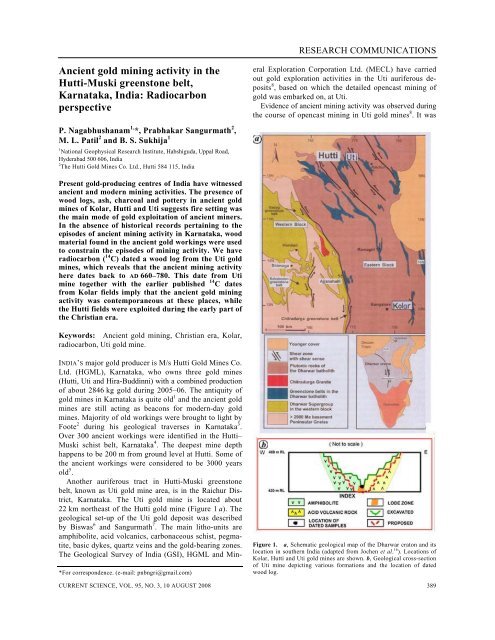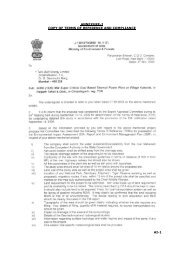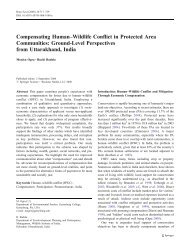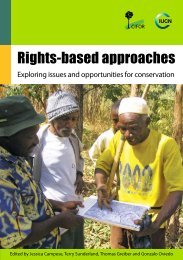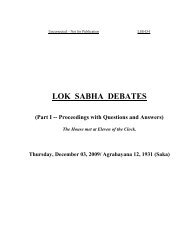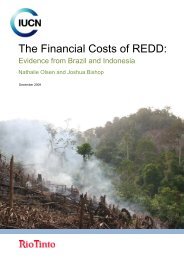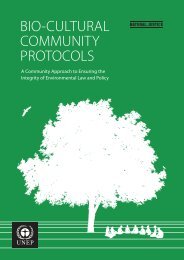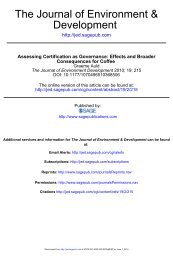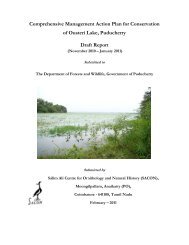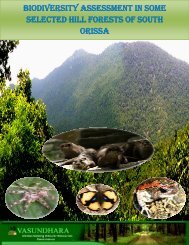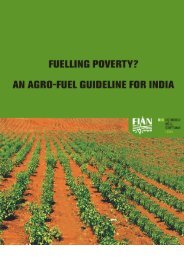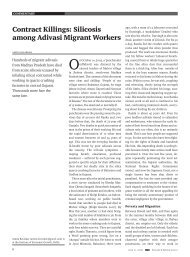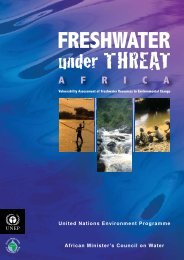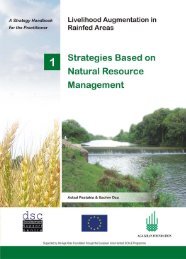Ancient gold mining activity in the Hutti-Muski - India Environment ...
Ancient gold mining activity in the Hutti-Muski - India Environment ...
Ancient gold mining activity in the Hutti-Muski - India Environment ...
You also want an ePaper? Increase the reach of your titles
YUMPU automatically turns print PDFs into web optimized ePapers that Google loves.
<strong>Ancient</strong> <strong>gold</strong> <strong>m<strong>in</strong><strong>in</strong>g</strong> <strong>activity</strong> <strong>in</strong> <strong>the</strong><br />
<strong>Hutti</strong>-<strong>Muski</strong> greenstone belt,<br />
Karnataka, <strong>India</strong>: Radiocarbon<br />
perspective<br />
P. Nagabhushanam 1, *, Prabhakar Sangurmath 2 ,<br />
M. L. Patil 2 and B. S. Sukhija 1<br />
1<br />
National Geophysical Research Institute, Habshiguda, Uppal Road,<br />
Hyderabad 500 606, <strong>India</strong><br />
2<br />
The <strong>Hutti</strong> Gold M<strong>in</strong>es Co. Ltd., <strong>Hutti</strong> 584 115, <strong>India</strong><br />
Present <strong>gold</strong>-produc<strong>in</strong>g centres of <strong>India</strong> have witnessed<br />
ancient and modern <strong>m<strong>in</strong><strong>in</strong>g</strong> activities. The presence of<br />
wood logs, ash, charcoal and pottery <strong>in</strong> ancient <strong>gold</strong><br />
m<strong>in</strong>es of Kolar, <strong>Hutti</strong> and Uti suggests fire sett<strong>in</strong>g was<br />
<strong>the</strong> ma<strong>in</strong> mode of <strong>gold</strong> exploitation of ancient m<strong>in</strong>ers.<br />
In <strong>the</strong> absence of historical records perta<strong>in</strong><strong>in</strong>g to <strong>the</strong><br />
episodes of ancient <strong>m<strong>in</strong><strong>in</strong>g</strong> <strong>activity</strong> <strong>in</strong> Karnataka, wood<br />
material found <strong>in</strong> <strong>the</strong> ancient <strong>gold</strong> work<strong>in</strong>gs were used<br />
to constra<strong>in</strong> <strong>the</strong> episodes of <strong>m<strong>in</strong><strong>in</strong>g</strong> <strong>activity</strong>. We have<br />
radiocarbon ( 14 C) dated a wood log from <strong>the</strong> Uti <strong>gold</strong><br />
m<strong>in</strong>es, which reveals that <strong>the</strong> ancient <strong>m<strong>in</strong><strong>in</strong>g</strong> <strong>activity</strong><br />
here dates back to AD 660–780. This date from Uti<br />
m<strong>in</strong>e toge<strong>the</strong>r with <strong>the</strong> earlier published 14 C dates<br />
from Kolar fields imply that <strong>the</strong> ancient <strong>gold</strong> <strong>m<strong>in</strong><strong>in</strong>g</strong><br />
<strong>activity</strong> was contemporaneous at <strong>the</strong>se places, while<br />
<strong>the</strong> <strong>Hutti</strong> fields were exploited dur<strong>in</strong>g <strong>the</strong> early part of<br />
<strong>the</strong> Christian era.<br />
Keywords: <strong>Ancient</strong> <strong>gold</strong> <strong>m<strong>in</strong><strong>in</strong>g</strong>, Christian era, Kolar,<br />
radiocarbon, Uti <strong>gold</strong> m<strong>in</strong>e.<br />
INDIA’S major <strong>gold</strong> producer is M/s <strong>Hutti</strong> Gold M<strong>in</strong>es Co.<br />
Ltd. (HGML), Karnataka, who owns three <strong>gold</strong> m<strong>in</strong>es<br />
(<strong>Hutti</strong>, Uti and Hira-Budd<strong>in</strong>ni) with a comb<strong>in</strong>ed production<br />
of about 2846 kg <strong>gold</strong> dur<strong>in</strong>g 2005–06. The antiquity of<br />
<strong>gold</strong> m<strong>in</strong>es <strong>in</strong> Karnataka is quite old 1 and <strong>the</strong> ancient <strong>gold</strong><br />
m<strong>in</strong>es are still act<strong>in</strong>g as beacons for modern-day <strong>gold</strong><br />
m<strong>in</strong>es. Majority of old work<strong>in</strong>gs were brought to light by<br />
Foote 2 dur<strong>in</strong>g his geological traverses <strong>in</strong> Karnataka 3 .<br />
Over 300 ancient work<strong>in</strong>gs were identified <strong>in</strong> <strong>the</strong> <strong>Hutti</strong>–<br />
<strong>Muski</strong> schist belt, Karnataka 4 . The deepest m<strong>in</strong>e depth<br />
happens to be 200 m from ground level at <strong>Hutti</strong>. Some of<br />
<strong>the</strong> ancient work<strong>in</strong>gs were considered to be 3000 years<br />
old 5 .<br />
Ano<strong>the</strong>r auriferous tract <strong>in</strong> <strong>Hutti</strong>-<strong>Muski</strong> greenstone<br />
belt, known as Uti <strong>gold</strong> m<strong>in</strong>e area, is <strong>in</strong> <strong>the</strong> Raichur District,<br />
Karnataka. The Uti <strong>gold</strong> m<strong>in</strong>e is located about<br />
22 km nor<strong>the</strong>ast of <strong>the</strong> <strong>Hutti</strong> <strong>gold</strong> m<strong>in</strong>e (Figure 1 a). The<br />
geological set-up of <strong>the</strong> Uti <strong>gold</strong> deposit was described<br />
by Biswas 6 and Sangurmath 7 . The ma<strong>in</strong> litho-units are<br />
amphibolite, acid volcanics, carbonaceous schist, pegmatite,<br />
basic dykes, quartz ve<strong>in</strong>s and <strong>the</strong> <strong>gold</strong>-bear<strong>in</strong>g zones.<br />
The Geological Survey of <strong>India</strong> (GSI), HGML and M<strong>in</strong>-<br />
*For correspondence. (e-mail: pnbngri@gmail.com)<br />
RESEARCH COMMUNICATIONS<br />
eral Exploration Corporation Ltd. (MECL) have carried<br />
out <strong>gold</strong> exploration activities <strong>in</strong> <strong>the</strong> Uti auriferous deposits<br />
8 , based on which <strong>the</strong> detailed opencast <strong>m<strong>in</strong><strong>in</strong>g</strong> of<br />
<strong>gold</strong> was embarked on, at Uti.<br />
Evidence of ancient <strong>m<strong>in</strong><strong>in</strong>g</strong> <strong>activity</strong> was observed dur<strong>in</strong>g<br />
<strong>the</strong> course of opencast <strong>m<strong>in</strong><strong>in</strong>g</strong> <strong>in</strong> Uti <strong>gold</strong> m<strong>in</strong>es 8 . It was<br />
Figure 1. a, Schematic geological map of <strong>the</strong> Dharwar craton and its<br />
location <strong>in</strong> sou<strong>the</strong>rn <strong>India</strong> (adapted from Jochen et al. 16 ). Locations of<br />
Kolar, <strong>Hutti</strong> and Uti <strong>gold</strong> m<strong>in</strong>es are shown. b, Geological cross-section<br />
of Uti m<strong>in</strong>e depict<strong>in</strong>g various formations and <strong>the</strong> location of dated<br />
wood log.<br />
CURRENT SCIENCE, VOL. 95, NO. 3, 10 AUGUST 2008 389
RESEARCH COMMUNICATIONS<br />
390<br />
Table 1.<br />
Site Sample no. Locus<br />
14 C dates from Uti, Kolar and <strong>Hutti</strong> <strong>gold</strong> m<strong>in</strong>es<br />
14 C age (yr BP) Calibrated date 15<br />
Uti N-928 ~40 m below reference level (Figure 1 b) 1290 ± 60 660 AD–780 AD<br />
Kolar* TF-1199 Superficial excavations 1290 ± 90 660 AD–860 AD<br />
Kolar* TF-879 Champion reef 50 m depth 1500 ± 115 430 AD–660 AD<br />
<strong>Hutti</strong>* Sample no. 1 Oakley’s shaft 80 m depth 1945 ± 70 40 BC–130 AD<br />
<strong>Hutti</strong>* Sample no. 2 Oakley’s shaft 80 m depth 1865 ± 70 70 AD–240 AD<br />
*Agrawal and Margabandhu 13 .<br />
Figure 2. Wood log obta<strong>in</strong>ed from <strong>the</strong> Uti ancient <strong>gold</strong> m<strong>in</strong>e.<br />
observed that <strong>the</strong>se old work<strong>in</strong>gs were stretch<strong>in</strong>g up to a<br />
depth of 20–25 m, and conta<strong>in</strong>ed wood, charcoal, ash,<br />
pottery, etc. The geological cross-section of <strong>the</strong> open-pit<br />
(Figure 1 b) shows presence of amphibolites <strong>in</strong> its western<br />
face, acid volcanic rocks <strong>in</strong> its eastern section, and<br />
<strong>the</strong> lode zone. M<strong>in</strong>eralization <strong>in</strong> <strong>the</strong> mafic rocks is ma<strong>in</strong>ly<br />
conf<strong>in</strong>ed to <strong>in</strong>tensely silicified and feldspathized amphibolite<br />
with th<strong>in</strong> str<strong>in</strong>gers, ve<strong>in</strong>s and ve<strong>in</strong>lets of quartz, associated<br />
with <strong>the</strong> sulphides (pyrite, arsenopyrite, pyrrhotite,<br />
etc.). M<strong>in</strong>eralization is notable with a uniform impregnation<br />
of silica <strong>in</strong> <strong>the</strong> ore zone. A wood log was collected<br />
from <strong>the</strong> m<strong>in</strong>eralized zone. On <strong>the</strong> basis of presence of<br />
wood, charcoal, ash, pottery, etc. <strong>in</strong> <strong>the</strong> old work<strong>in</strong>gs, it<br />
was <strong>in</strong>terpreted that ancient m<strong>in</strong>ers extracted <strong>the</strong> ore<br />
through fire-sett<strong>in</strong>g process followed by water-cool<strong>in</strong>g of<br />
<strong>the</strong> heated rock. This was evident from <strong>the</strong> presence of<br />
visible <strong>gold</strong> over <strong>the</strong> surface of charcoal coated burnt<br />
quartz <strong>in</strong> <strong>the</strong> open pit old work<strong>in</strong>gs 8 .<br />
Forbes 9 observed that <strong>in</strong> ancient times <strong>the</strong> ma<strong>in</strong> supply<br />
of <strong>gold</strong> was from Egyptian deserts of Nubia. The Egyptians<br />
were known to have m<strong>in</strong>ed <strong>gold</strong> <strong>in</strong> Nubian sands<br />
6000 years ago, and cont<strong>in</strong>ued for many centuries 10 . It<br />
appears that <strong>the</strong> Rhodesians were <strong>in</strong>spired by <strong>the</strong> ancient<br />
<strong>m<strong>in</strong><strong>in</strong>g</strong> <strong>activity</strong> of Karnataka, and developed <strong>the</strong>ir <strong>m<strong>in</strong><strong>in</strong>g</strong><br />
<strong>activity</strong> s<strong>in</strong>ce 3rd century 11 . M<strong>in</strong><strong>in</strong>g of ores <strong>in</strong> Karnataka<br />
spans as back as centuries preced<strong>in</strong>g and immediately follow<strong>in</strong>g<br />
<strong>the</strong> Christian era 5 . With a view to unravel<strong>in</strong>g <strong>the</strong><br />
epochs of ancient work<strong>in</strong>gs <strong>in</strong> Ingaldhal copper ore<br />
m<strong>in</strong>es, Shankar 12 carried out <strong>the</strong> 14 C dat<strong>in</strong>g of wood logs<br />
obta<strong>in</strong>ed from <strong>the</strong> old work<strong>in</strong>gs of Ingaldhal copper<br />
m<strong>in</strong>es of Karnataka, and concluded that <strong>the</strong> ancient <strong>m<strong>in</strong><strong>in</strong>g</strong><br />
<strong>activity</strong> belonged to <strong>the</strong> Satavahana period (2nd century<br />
BC to 2nd century AD). Similar studies 13 <strong>in</strong> <strong>the</strong> ancient<br />
<strong>gold</strong> work<strong>in</strong>gs of Kolar <strong>gold</strong> m<strong>in</strong>es revealed existence of<br />
<strong>m<strong>in</strong><strong>in</strong>g</strong> <strong>activity</strong> dur<strong>in</strong>g 5th to 7th century AD, while <strong>in</strong><br />
<strong>Hutti</strong> <strong>gold</strong> m<strong>in</strong>es <strong>the</strong> epoch of ancient <strong>gold</strong> exploitation<br />
<strong>activity</strong> was much earlier (perta<strong>in</strong>ed to <strong>the</strong> beg<strong>in</strong>n<strong>in</strong>g of<br />
Christian era; Table 1). It appears that due to overlap of<br />
14 C dates (1290 ± 90 and 1500 ± 115 yr BP; Table 1) from<br />
Kolar m<strong>in</strong>es, Agrawal and Margabandhu 13 op<strong>in</strong>ed that <strong>the</strong><br />
<strong>gold</strong> fields were exploited from 5th century AD.<br />
In <strong>the</strong> present study, <strong>the</strong> tim<strong>in</strong>g of ancient <strong>gold</strong> exploitation<br />
<strong>in</strong> <strong>the</strong> Uti <strong>gold</strong> m<strong>in</strong>es was constra<strong>in</strong>ed through radiocarbon<br />
dat<strong>in</strong>g of wood log (Figure 2) recovered from<br />
<strong>the</strong> m<strong>in</strong>e by one of <strong>the</strong> authors (PS). The wood log was<br />
subjected to preprocess<strong>in</strong>g procedure and combustion of<br />
wood for extraction of carbon dioxide (CO2), syn<strong>the</strong>sis of<br />
acetylene and benzene from <strong>the</strong> extracted CO2, and residual<br />
radiocarbon <strong>activity</strong> determ<strong>in</strong>ation us<strong>in</strong>g low level liquid<br />
sc<strong>in</strong>tillation counter 14 . The wood sample was partitioned<br />
<strong>in</strong>to three parts, each part separately combusted for extraction<br />
of CO2, syn<strong>the</strong>sized acetylene and benzene and determ<strong>in</strong>ed<br />
14 C date. Average date was computed from <strong>the</strong><br />
three <strong>in</strong>dependent dates. For radiocarbon age calculation<br />
of <strong>the</strong> wood log, 5730 yr half-life and δ 13 C of –25‰ were<br />
used. The dated wood showed an age of 1290 ± 60 yr BP.<br />
The calibrated 15 date of <strong>the</strong> wood is 660–780 AD (1σ error).<br />
It is <strong>in</strong>terest<strong>in</strong>g to note that <strong>the</strong> present radiocarbon<br />
date (1290 ± 60 yr BP) of <strong>the</strong> wood log from <strong>the</strong> Uti ancient<br />
<strong>gold</strong> work<strong>in</strong>g and <strong>the</strong> date (1290 ± 90 yr BP) reported<br />
by Agrawal and Margabandhu 13 for <strong>the</strong> Kolar <strong>gold</strong><br />
field ancient work<strong>in</strong>gs toge<strong>the</strong>r reveal contemporaneous<br />
<strong>m<strong>in</strong><strong>in</strong>g</strong> <strong>activity</strong> at both <strong>the</strong> <strong>gold</strong> fields.<br />
We conclude from <strong>the</strong> 14 C date of wood log obta<strong>in</strong>ed<br />
from Uti ancient <strong>gold</strong> m<strong>in</strong>e and from <strong>the</strong> published 14 C<br />
dates perta<strong>in</strong><strong>in</strong>g to <strong>the</strong> ancient <strong>m<strong>in</strong><strong>in</strong>g</strong> activities at <strong>Hutti</strong><br />
and Kolar <strong>gold</strong> fields, that <strong>the</strong> <strong>gold</strong> exploitation was ei<strong>the</strong>r<br />
contemporaneous around 7th century AD at Uti and Kolar<br />
auriferous tracts or it followed after probable (?) cessation<br />
of <strong>m<strong>in</strong><strong>in</strong>g</strong> <strong>activity</strong> at <strong>Hutti</strong> fields, which were exploited<br />
dur<strong>in</strong>g <strong>the</strong> early part of <strong>the</strong> Christian era. The present<br />
f<strong>in</strong>d<strong>in</strong>g and that of Agrawal and Margabandhu 13 raise two<br />
issues to be addressed. One issue perta<strong>in</strong>s to <strong>the</strong> cont<strong>in</strong>uation<br />
of <strong>gold</strong> <strong>m<strong>in</strong><strong>in</strong>g</strong> <strong>activity</strong> <strong>in</strong> <strong>the</strong> Deccan between 5th<br />
and 7th century AD <strong>in</strong> contrast to <strong>the</strong> observation by Curtis<br />
and Radhakrishna 5 that <strong>the</strong> <strong>gold</strong> <strong>m<strong>in</strong><strong>in</strong>g</strong> <strong>activity</strong> <strong>in</strong> <strong>the</strong><br />
Deccan ceased completely between 5th and 6th century AD.<br />
CURRENT SCIENCE, VOL. 95, NO. 3, 10 AUGUST 2008
The second issue concerns <strong>the</strong> 1200-year long period<br />
dormancy of <strong>gold</strong> <strong>m<strong>in</strong><strong>in</strong>g</strong> <strong>activity</strong> after 6th century AD 5 .<br />
Answers to <strong>the</strong>se issues, perhaps, lay <strong>in</strong> <strong>the</strong> episodes of<br />
o<strong>the</strong>r ancient <strong>gold</strong> <strong>m<strong>in</strong><strong>in</strong>g</strong> activities <strong>in</strong> <strong>the</strong> Deccan, which<br />
needs to be unraveled.<br />
1. Allch<strong>in</strong>, F. R., Upon <strong>the</strong> antiquity and methods of <strong>gold</strong> <strong>m<strong>in</strong><strong>in</strong>g</strong> <strong>in</strong><br />
ancient <strong>India</strong>. J. Eco. So. Hist. Orient, 1962, 5, 195–211.<br />
2. Foote, R. B., Notes on a traverse across some <strong>gold</strong>fields of Mysore.<br />
Rec. Geol. Surv. <strong>India</strong>, 1882, 4, 191–202.<br />
3. Anantharamu, T. R., Shivarudrappa, T. V. and Gururaja Rao, B. K.,<br />
History of <strong>gold</strong> <strong>in</strong> Karnataka: The problems and prospects. Arts J.<br />
(Plat<strong>in</strong>um Jubilee Spl. Issue), 1992, LIV, 93–104.<br />
4. Maclaren, J. M., Notes on some auriferous tracts <strong>in</strong> sou<strong>the</strong>rn <strong>India</strong>.<br />
Rec. Geol. Surv. <strong>India</strong>, 1906, 34, 96–131.<br />
5. Curtis, L. C. and Radhakrishna, B. P., M<strong>in</strong>eral Resources of<br />
<strong>India</strong> – <strong>Hutti</strong> Gold M<strong>in</strong>e <strong>in</strong>to <strong>the</strong> 21st Century, Geological Society<br />
of <strong>India</strong>, Bangalore, 1995.<br />
6. Biswas, S. K., Gold m<strong>in</strong>eralization <strong>in</strong> UTI block of <strong>Hutti</strong>-Maski<br />
supracrustal belt, Karnataka. J. Geol. Soc. <strong>India</strong>, 1990, 36,<br />
79–89.<br />
7. Sangurmath, P., UTI <strong>gold</strong> deposit – Evolv<strong>in</strong>g scene, <strong>Hutti</strong>-Maski<br />
greenstone belt, <strong>India</strong>. Geol. Surv. Ind. Spl. Pub., 2001, 58, 289–<br />
292.<br />
8. Sangurmath, P., The geological sett<strong>in</strong>g, structure and <strong>gold</strong><br />
m<strong>in</strong>eralization of UTI open-cast m<strong>in</strong>e, <strong>Hutti</strong>-Maski greenstone<br />
belt, Karnataka. M<strong>in</strong><strong>in</strong>g Eng<strong>in</strong>eer’s J., 2003, 5, 19–21.<br />
9. Forbes, R. J., Man, <strong>the</strong> Maker: A History of Eng<strong>in</strong>eer<strong>in</strong>g and<br />
Technology, Schuman, London, 1950, p. 365.<br />
10. Kavanaugh, P. M., Have 6000 years of <strong>gold</strong> <strong>m<strong>in</strong><strong>in</strong>g</strong> exhausted <strong>the</strong><br />
world’s <strong>gold</strong> reserves? Can. M<strong>in</strong>. Metall. Bull., 1968, 61, 553–<br />
558.<br />
11. Anhaeusser, C. R., The nature and distribution of archaean <strong>gold</strong><br />
m<strong>in</strong>eralization <strong>in</strong> sou<strong>the</strong>rn Africa. M<strong>in</strong>. Sci. Eng., 1976, 8, 46.<br />
12. Shankar, R., How old are <strong>the</strong> old m<strong>in</strong>e work<strong>in</strong>gs of Ingaldhal<br />
(Karnataka)? J. Geol. Soc. <strong>India</strong>, 1989, 33, 64–70.<br />
13. Agrawal, D. P. and Margabandhu, C., <strong>Ancient</strong> <strong>gold</strong> work<strong>in</strong>gs:<br />
Some new 14 C dates. Puratattva, 1975–76, 78, 138–139.<br />
14. Gupta, S. K. and Polach, H., Radiocarbon dat<strong>in</strong>g practices at ANU.<br />
Radiocarbon lab Res School of Pac. Studies, Australian National<br />
University, Canberra, 1985, p. 176.<br />
15. Stuiver, M. et al., Radiocarbon calibration program rev 4.3.<br />
Radiocarbon, 1998, 40, 1041–1083.<br />
16. Jochen, K., Rogers, A. and Meyer, M., Relative tim<strong>in</strong>g of deformation<br />
and two stage <strong>gold</strong> m<strong>in</strong>eralization at <strong>the</strong> <strong>Hutti</strong> m<strong>in</strong>e, Dharwar<br />
Craton, <strong>India</strong>. M<strong>in</strong>. Dep., 2005, 40, 15–174.<br />
ACKNOWLEDGEMENTS. We thank Director, NGRI, for permission<br />
to publish <strong>the</strong> paper; Mr Syed Hussa<strong>in</strong> and Ms M. S. Bhagyavathi<br />
for process<strong>in</strong>g <strong>the</strong> wood sample, and <strong>the</strong> management of M/s HGML,<br />
<strong>Hutti</strong>, for encouragement and support.<br />
Received 19 May 2008; accepted 9 July 2008<br />
RESEARCH COMMUNICATIONS<br />
Analysis and mapp<strong>in</strong>g of soil quality<br />
<strong>in</strong> Khandaleru catchment area us<strong>in</strong>g<br />
remote sens<strong>in</strong>g and GIS<br />
S. S. Asadi*, S. Azeem, A. V. S. Prasad and<br />
M. Anji Reddy<br />
Centre for <strong>Environment</strong>, Institute of Science & Technology, Jawaharlal<br />
Nehru Technological University, Hyderabad 500 085, <strong>India</strong><br />
The problem of soil quality <strong>in</strong> and around reservoirs<br />
is attract<strong>in</strong>g attention for <strong>the</strong> last couple of years due<br />
to <strong>the</strong> unscientific and unplanned irrigation practices<br />
that are br<strong>in</strong>g<strong>in</strong>g a myriad problems. Modern agricultural<br />
practices such as pump<strong>in</strong>g of groundwater for<br />
irrigation and <strong>in</strong>discrim<strong>in</strong>ate use of fertilizers conta<strong>in</strong><strong>in</strong>g<br />
toxic substances contribute to environmental degradation.<br />
Such anthropogenic activities <strong>in</strong>variably result<br />
<strong>in</strong> <strong>the</strong> depletion of water bodies, deterioration of soil<br />
quality, contam<strong>in</strong>ation of dr<strong>in</strong>k<strong>in</strong>g water and various<br />
health hazards. Hence <strong>the</strong>re is need to study <strong>in</strong> a comprehensive<br />
manner about <strong>the</strong> soil quality issues <strong>in</strong> <strong>the</strong><br />
catchment areas. The present study is an attempt to<br />
analyse <strong>the</strong> physico-chemical parameters and generate<br />
<strong>the</strong> soil quality <strong>in</strong>dex (SQI) <strong>in</strong> and around Khandaleru<br />
catchment, Nellore District, Andhra Pradesh. The soil<br />
samples collected at <strong>the</strong> predeterm<strong>in</strong>ed locations were<br />
analysed for physico-chemical parameters for <strong>the</strong> generation<br />
of attribute database. Based on <strong>the</strong> results of<br />
<strong>the</strong> analysis, spatial distribution maps of selected soil<br />
quality parameters, namely bulk density, moisture<br />
content, organic matter, C%, pH, electrical conductivity,<br />
Ca, Mg, SO4, nitrate, phosphorus, potassium and<br />
texture were prepared us<strong>in</strong>g curve-fitt<strong>in</strong>g method <strong>in</strong><br />
GIS software. The physico-chemical analysis properties<br />
and computation of SQI are helpful <strong>in</strong> <strong>the</strong> group<strong>in</strong>g of<br />
soil samples <strong>in</strong>to excellent, good, poor, very poor and<br />
unfit. The spatial distribution of SQI generated <strong>in</strong> <strong>the</strong><br />
current study will be of use for planners <strong>in</strong> <strong>the</strong> management<br />
and monitor<strong>in</strong>g of land resources.<br />
Keywords: Physico-chemical parameters, remote sens<strong>in</strong>g<br />
and GIS, soil quality <strong>in</strong>dex, spatial distribution.<br />
SOIL is a liv<strong>in</strong>g system that represents a f<strong>in</strong>ite resource<br />
vital to life on earth. It forms a th<strong>in</strong> sk<strong>in</strong> of unconsolidated<br />
m<strong>in</strong>erals and organic matter on <strong>the</strong> earth’s surface. It<br />
develops slowly from various parent materials and is<br />
modified by time, climate, macro- and microorganisms,<br />
vegetation and topography. Soils are complex mixtures of<br />
m<strong>in</strong>erals, organic compounds and liv<strong>in</strong>g organisms that<br />
<strong>in</strong>teract cont<strong>in</strong>uously <strong>in</strong> response to natural and imposed<br />
biological, chemical and physical forces. People are dependent<br />
on <strong>the</strong> soil, and conversely, good soils are dependent<br />
on people and <strong>the</strong> use <strong>the</strong>y make of <strong>the</strong> land. Soils<br />
are <strong>the</strong> natural bodies <strong>in</strong> which plants grow. The soils<br />
*For correspondence. (e-mail: ssvp_envi@yahoo.co.<strong>in</strong>)<br />
CURRENT SCIENCE, VOL. 95, NO. 3, 10 AUGUST 2008 391


